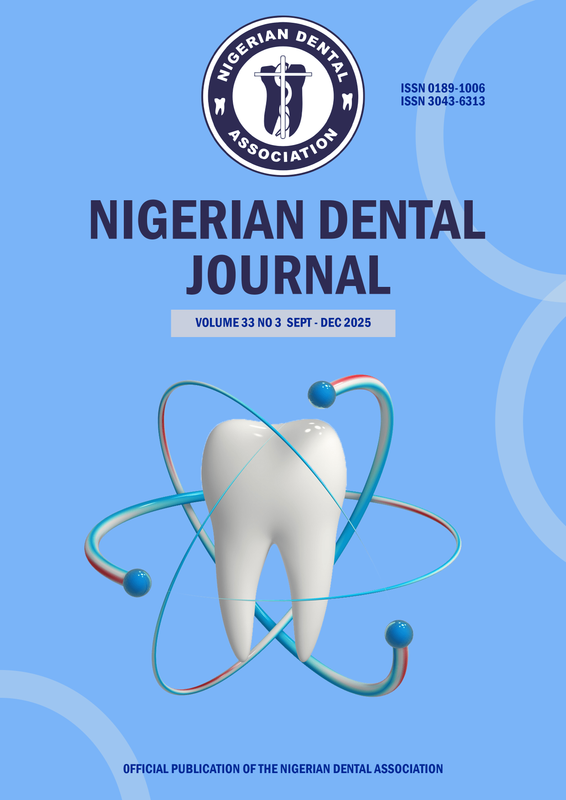Prevalence and Pattern of Labial Frenal Attachments in Adult Nigerians - a Pilot Study
DOI:
https://doi.org/10.61172/6v9d5j16Keywords:
Frenal attachments, diastema, mucosal, gingival, papillaryAbstract
Introduction
The frenum is a band of mucous membrane which connects the lips and cheeks to the alveolar mucosa, underlying periosteum, or the gingiva with a primary function of stabilizing the lips and tongue. There are variations of frenal attachment and morphologies, some associated with health, others resulting to loss of periodontium. This study therefore aims to assess the various attachments and morphologies within our study population.
Materials and Methods
This was a descriptive cross-sectional study conducted at the Oral Diagnosis and Periodontology clinics of the Lagos University Teaching Hospital Idi-Araba among participants who reported to both clinics. Convenience sampling method was employed in participants’ selection, and interviewer-administered questionnaires were used for data collection and documentation of socio-demographic variables, and findings of intra-oral examination. Ethical approval was obtained from the institutional Health Research Ethics Committee and informed consent was obtained from each participant. Data was analyzed using the Statistical Product and Service Solutions (SPSS) version 27. P values < 0.05 were statistically significant.
Results
The study comprised 337 participants, 203 (60.2%) were females. Mean age was 34.6±15.2 years. The frenal attachment distribution in the maxilla was mucosal 204 (60.5%), gingival 105 (31.2%), papillary 23 (6.8%), and papillary penetrating 5 (1.5%);while in the mandible, 233 (69.1%), 92 (27.3%), 9 (2.7%) and 3 (0.9%) presented with mucosal, gingival, papillary, and papillary penetrating frenal attachment respectively. Simple frenum was the most prevalent frenum morphology in the maxilla [328 (97.3%)] and the mandible [321 (95.2%)], followed by trifid frenum in both maxilla [5 (1.5%)] and mandible [4 (1.2%)]. Diastema was present in 27.6% in maxilla and 11.0% in the mandible.
Conclusion
In this study, mucosal type was predominant among all age groups. Males presented more with gingival and mucosal type of frenal insertion, while females presented more with papillary type of frenal insertion. Papillary and/or papillary penetrating were significantly associated with the presence of diastema.
Downloads
References
Newman Michael TH. Periodontal plastic and esthetic Surgery. In: Carranza’s clinical periodontolgy. 11th edition. 20112. p. 595–600.
Priyanka M, Sruthi R RTEP. An overview of frenal attachments. J Indian Soc Periodontol. 2013;17:12–5.
Priyanka M, Emmadi P AN. An overview of frenal attachments. J Indian Soc Periodontol. 2013;17:12.
Mintz SM, Siegel M SP. An overview of oral frena and their association with syndrome and non-sydromic conditions. Oral Surg Oral Med Oral Pathol Oral Radiol Endod. 2005;99:321–4.
Mohan R, Soni P, Gundappa M KMd. Proposed classification of medial maxillary labial frenum based on morphology. Dental hypothesis. 2014;5(11):16–20.
Hammouri E, Ghozlan M, Alsmadi H. Morphology and Positional Characteristics of Maxillary Labial Frenum in Jordanian Children. Journal of the Royal Medical Services. 2017 Aug;24(2):35–40.
Mirko P, Miroslav S, Lubor M. Significance of the labial frenum attachment in periodontal disease in man. Part I. Classification and epidemiology of the labial frenum attachment. J Periodontol. 1974 Dec;45(12):891–4.
Sewerin I. Prevalence of variation and anomalies of the upper labial frenum. Acta Odontol Scand. 1971;29(4):487–96.
Jindal V, Kaur R, Goel A, Mahajan A MN. Variations in the frenal morphology in the diverse population: A clinical study. J Indian Soc Periodontol. 2016;20(3):320–3.
Wiessinger D, Miller M. Breastfeeding difficulties as a result of tight lingual and labial frena: a case report. J Hum Lact. 1995;11(4):313–6.
De Felice C, Toti P, Di Maggio G, Parrini S, Bagnoli F. NAbsence of the inferior labial and lingual frenula in Ehlers-Danlos syndromeo Title. Lancet. 2001;357(92671):1500–2.
Syed S, Sawant PR, Spadigam A, Dhupar A. Oro-facial-digital syndrome type I: a case report with novel features. Autops Case Rep. 2021;11:e2021315. doi:10.4322/acr.2021.315.
Felemban R, Mawardi H. Congenital absence of lingual frenum in a non-syndromic patient: a case report. J Med Case Rep. 2019 Mar 10;13(1):56. doi: 10.1186/s13256-018-1966-7.
Divater V, Bali P, Nawab A, Hiremath N, Jain J KD. Frenal attachment and its association with oral hygiene status among adolescents in Dakshina Kannada population : A cross sectional study. J Fam Med Prim Care. 2019;8:3664–7.
Khursheed DA, Zorab SS, Zardawi FM, Ali AJ TRM. Prevalence of Labial Frenum Attachment and its Relation to Diastemia and Black Hole in Kurdish Young Population. IOSR-JDMS. 2015;14(9):97–100.
Rajani ER, Biswas PP ER. Prevalence of variations in morphology and attachment of maxillary labial frenum in various skeletal patterns. J Indian Soc Periodontol. 2018;22:257–62.
Janarthanan S, Arun RT, Srinivasan S KS. Frenectomy with Laterally Displaced Flap : A Case Series. Indian J Dent Sci. 2019;11:112–5.
Díaz-Pizán ME, Lagravère MO, Villena R. Midline diastema and frenum morphology in the primary dentition. J Dent Child (Chic). 2006;73(1):11-4.
Abullais SS, Dani N, Ningappa P, Golvankar K, Chavan A, Malgaonkar N et al. Paralleling technique for frenectomy and oral hygiene evaluation after frenectomy. J Indian Soc Periodontol. 2016;20:28–31.
Miller PD Jr. The frenectomy combined with a laterally positioned pedicle graft. Functional and esthetic considerations. J Periodontol. 1985;56(2):102-6. doi:10.1902/jop.1985.56.2.102
Thirumagal K, Varghese S, Jain RK. Factors associated with high frenal attachment and frenectomy. Eur J Mol Clin Med. 2020;7(1):2010–20.
Christabel SL, Gurunathan D. Prevalence of Type of Frenal Attachment and Morphology of Frenum in Children, Chennai, Tamil Nadu doi: World J Dent. 2015;6(4)203–207.
Mirko P, Miroslav S, Lubor M. Significance of the labial frenum attachment in periodontal disease in man. Part I. Classification and epidemiology of the labial frenum attachment. J Periodontol. 1974;45(12):891-4. doi: 10.1902/jop.1974.45.12.891
Logeswari J, Suresh S, Anbudaiyan S, Shreeyha RSG. Prevalence of Midline Diastema and Willingness for Treatment in Adults of Chennai: A Cross-sectional Study. J Clin Diagnostic Res. 2021;15(11):ZC19–23.
Sękowska A, Chałas R. Diastema size and type of upper lip midline frenulum attachment. Folia Morphol (Warsz). 2017;76(3):501-505. doi: 10.5603/FM.a2016.0079
Townsend JA, Brannon RB, Cheramie T HJ. Prevalence and variations of the median maxillary labial frenum in children, adolescents, and adults in a diverse population. Gen Dent. 2013;61:57–60.
Joshi U, Pradhan M, Neupane A, Lawaju N, Khadka N CR. Variations in Maxillary frenal morphology in a sample of Newari children of Bhaktapur. J Nepal Soc Perio Oral Implantol. 2021;5(9):34–8.
Surekha Rathod, Pranjali V. Bawankar, Pallavi Chikhale AB. Evaluation of variations in morphology and attachment of frenum in diverse population - A cross-sectional study. Clin Epidemiol Glob Health. 2020;8(4):1094–7.
Oji C, Obiechina AE. Diastema in Nigerian society. Odontostomatol Trop 1994;17(68):4-6
Downloads
Published
Issue
Section
License
Copyright (c) 2024 Kehinde UMEIZUDIKE, Grace ALADE, Ayodele OGUNDANA

This work is licensed under a Creative Commons Attribution 4.0 International License.
Open Access Statement
- We became fully Open Access since January 2023.
- Our new and archived materials are available free of charge on open basis and under a Creative Commons license as stated below.
Copyright statement
Copyright © 1999 The authors. This work, Nigerian Dental Journal by Nigerian Dental Association is licensed under Creative Commons Attribution 4.0 International License.


